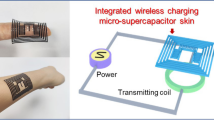Abstract
This paper presents the design and fabrication of a low-cost series microheater which works on the principle of Joule heating. The conducting silver-ink (LOCTITE ECI 1010 E & C) and polyethylene terephthalate (PET) sheet are used as a resistive material for the heating circuit and the substrate respectively. The poor thermal conductivity and high electrical resistivity of the PET sheet are advantageous in achieving the excellent heat confinement. Conventional screen printing is used to fabricate the microheater. Screen printing offers high yield with low turnaround time and fabrication can be done with minimum facilities. The maximum operating temperature of microheater is 100 \({^\circ }{\mathrm{C}}\), and it may have promising application in the bio-medical analysis. To improve the thermal uniformity, a 100 μm thick glass coverslip is glued on the heater surface. The influence of supply voltage and time on heater temperature profile is predicted using commercial FEM simulation tool—COMSOL Multiphysics. There is good agreement between the measured and simulation results.













Similar content being viewed by others

References
Chung G-S (2004) Fabrication and characterization of micro-heaters with low-power consumption using SOI membrane and trench structures. Sens Actuators A Phys 112(1):55–60
Chuang H-S, Wereley S (2009) Design, fabrication and characterization of a conducting PDMS for microheaters and temperature sensors. J Micromech Microeng 19(4):045010
Courbat J, Canonica M, Teyssieux D, Briand D, De Rooij NF (2010) Design and fabrication of micro-hotplates made on a polyimide foil: electrothermal simulation and characterization to achieve power consumption in the low mW range. J Micromech Microeng 21(1):015014
Crowley K, Morrin A, Shepherd RL, Panhuis M, Wallace GG, Smyth MR, Killard AJ (2010) Fabrication of polyaniline-based gas sensors using piezoelectric inkjet and screen printing for the detection of hydrogen sulfide. IEEE Sens J 10(9):1419–1426
Hsieh T-M, Luo C-H, Huang F-C, Wang J-H, Chien L-J, Lee G-B (2008) Enhancement of thermal uniformity for a microthermal cycler and its application for polymerase chain reaction. Sens Actuators B Chem 130(2):848–856
Hyun WJ, Secor EB, Hersam MC, Frisbie CD, Francis LF (2015) High-resolution patterning of graphene by screen printing with a silicon stencil for highly flexible printed electronics. Adv Mater 27(1):109–115
Kundu P, Bhattacharyya TK, Das S (2014) Electro-thermal analysis of an embedded boron diffused microheater for thruster applications. Microsyst Technol 20(1):23–33
Lee C-Y, Lee G-B, Lin J-L, Huang F-C, Liao C-S (2005) Integrated microfluidic systems for cell lysis, mixing/pumping and DNA amplification. J Micromech Microeng 15(6):1215
Li S, Fozdar DY, Ali MF, Li H, Shao D, Vykoukal DM, Vykoukal J, Floriano PN, Olsen M, McDevitt JT et al (2006) A continuous-flow polymerase chain reaction microchip with regional velocity control. J Microelectromech Syst 15(1):223–236
Lin J-L, Wu M-H, Kuo C-Y, Lee K-D, Shen Y-L (2010) Application of indium tin oxide (ITO)-based microheater chip with uniform thermal distribution for perfusion cell culture outside a cell incubator. Biomed Microdevices 12(3):389–398
Lou-Moeller R, Hindrichsen CC, Thamdrup LH, Bove T, Ringgaard E, Pedersen AF, Thomsen EV (2007) Screen-printed piezoceramic thick films for miniaturised devices. J Electroceramics 19(4):333–338
Park S, Zhang Y, Lin S, Wang T-H, Yang S (2011) Advances in microfluidic PCR for point-of-care infectious disease diagnostics. Biotechnol Adv 29(6):830–839
Voigt MM, Guite A, Chung D-Y, Khan RUA, Campbell AJ, Bradley DDC, Meng F, Steinke JHG, Tierney S, McCulloch I et al (2010) Polymer field-effect transistors fabricated by the sequential gravure printing of polythiophene, two insulator layers, and a metal ink gate. Adv Funct Mater 20(2):239–246
Weste N, Harris D (2015) CMOS VLSI design: a circuits and systems perspective. Pearson Education India, New Delhi, pp 488–489
Xu R, Lei A, Dahl-Petersen C, Hansen K, Guizzetti M, Birkelund K, Thomsen EV, Hansen O (2012) Screen printed PZT/PZT thick film bimorph MEMS cantilever device for vibration energy harvesting. Sens Actuators A Phys 188:383–388
Yunus CA, Afshin J (2015) GHAJAR, Heat and Mass Transfer: Fundamentals and Applications. McGraw-Hill, New York, pp 17–28
Acknowledgements
Authors in this paper are thankful to Manipal Technologies Ltd. for allowing the access to their laboratory facilities.
Author information
Authors and Affiliations
Corresponding author
Rights and permissions
About this article
Cite this article
Tiwari, S.K., Bhat, S. & Mahato, K.K. Design and fabrication of screen printed microheater. Microsyst Technol 24, 3273–3281 (2018). https://doi.org/10.1007/s00542-018-3821-6
Received:
Accepted:
Published:
Issue Date:
DOI: https://doi.org/10.1007/s00542-018-3821-6



